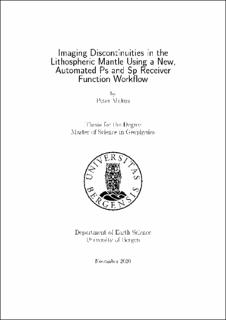| dc.description.abstract | Over the last decades, the receiver function technique has been widely established as a standard tool for surveying sharp changes in elastic properties of the Earth’s crust and upper mantle. To date, very few studies have attempted to use receiver functions for global imaging. To overcome the lack of toolsets for global receiver function imaging, I have developed PyGLImER - a Python-based software suite capable of creating global images from both P-to-S and S-to-P converted teleseismic waves via a comprehensive receiver function workflow. In this thesis, I discuss the functionalities of PyGLImER and demonstrate its efficiency, effectiveness, and robustness on synthetic and real earthquake data examples. I show images from receiver functions, binned and stacked by conversion point, from four regions, one of which - North America - is the focus of a more thorough discussion. The receiver function survey of the North American continent presented here is of unprecedented size resulting in high-resolution images which allow to accurately constrain the depth of the cratonic lithosphere-asthenosphere boundary, make new observations of a positive correlation between the number of midlithospheric discontinuities (MLD) and the age of the lithosphere, and identify a sharp transition from the Proterozoic belts dominated by dipping structures to Archean cratons dominated by horizontal and subhorizontal MLDs. Those observations lead me to make the following hypotheses: (1) Thick continental lithosphere is formed by cyclic (i.e., periodic) processes. (2) In hotter Archean times, the formation of continents was dominated by plume-induced mechanisms (subcretion) causing horizontal MLDs, whereas, in the later Precambrian, the dominance shifted towards subduction accretion. (3) Considering (1) and (2), I deem MLDs to be caused by layers of frozen melt as previously suggested by petrological studies. | |
